|

Early Concepts and Character
Development
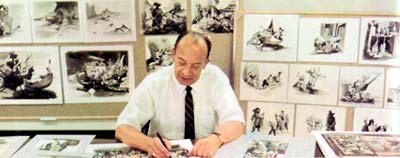
Meanwhile, Marc Davis (left) continued creating hundreds
of sketches, drawings and paintings as he developed scenes
for the ride. "They were excavating [for New Orleans
Square], so I went to work on ideas for a walk-through attraction,"
he recalled.
By previously discussing the Audio-Animatronics and the
transportation system Arrow developed, we are really getting
ahead of the story. POTC was an idea being worked on as
early as the late '50s, soon after Disneyland proved itself
a popular success. When Walt first considered expanding
the park to include a New-Orleans-themed section, the Pirates
attraction was considered as a walk-through exhibit beneath
the New Orleans streets; a sort-of glorified wax museum
in the bowels of the bayou, you could say.
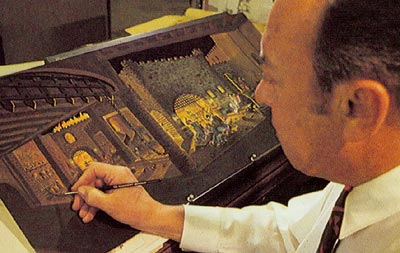
Many of Walt's finest artists and designers worked on the
Pirates of the Caribbean attraction, though Marc Davis was
heavily responsible for the characters and gags employed
throughout the ride, basing some of his early works on art
by famed pirate artist H.C. Pyle. Above, Davis is pictured
painting a detailed scene from the attraction in its early
stages of design.
Design and Progress
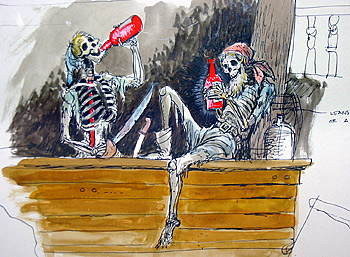 Early
on, the walk-through Pirates attraction was to feature scenes
of famous pirates from history, and Davis worked on many
illustrations to this extent. However, after the success
of the WED Audio-Animatronic designs at the '64 World's
Fair discussed above, the company was inspired to push the
technological envelope and create robots that could imitate
living beings. The proposed attraction was rethought, and
the idea to provide a ride-through exhibit that immersed
the viewer in the action (rather than display rather static
displays) was embraced, and a storyline was developed to
follow this idea. Early
on, the walk-through Pirates attraction was to feature scenes
of famous pirates from history, and Davis worked on many
illustrations to this extent. However, after the success
of the WED Audio-Animatronic designs at the '64 World's
Fair discussed above, the company was inspired to push the
technological envelope and create robots that could imitate
living beings. The proposed attraction was rethought, and
the idea to provide a ride-through exhibit that immersed
the viewer in the action (rather than display rather static
displays) was embraced, and a storyline was developed to
follow this idea.
 The
pirate characters were first designed as sketches and cartoons,
and their actions were illustrated on storyboards. As this
was being completed, a scale model of the attraction was
also being built, with 9-inch characters. The "auction"
scene, now one of the attraction's showpieces, was actually
a late addition to the attraction. The
pirate characters were first designed as sketches and cartoons,
and their actions were illustrated on storyboards. As this
was being completed, a scale model of the attraction was
also being built, with 9-inch characters. The "auction"
scene, now one of the attraction's showpieces, was actually
a late addition to the attraction.
In the two illustrations above, you can see an example
of a sketched scene of the auction (which was developed
after the initial ride scenes had already been determined)
and the clay maquette version, which was used to determine
exact positioning. Note the incredible detail evident in
even preliminary models. Also note how closely the actual
ride's layout matches the conceptual sketch.
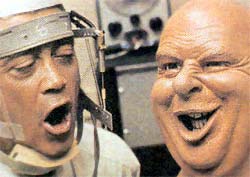 |
Walt Disney himself "cast" the roles of
the pirates to live actors and workers whom the WED
engineers would replicate in clay to create the full-sized
pirates and buccaneers. The actors would perform the
action that the pirate was to follow, and this action
would be filmed. WED programmers then used the film
as reference material to animate the Audio-Animatronics.
|
|
WED described this innovative process by using the
phrase "space age" in the 1970s, though
the technology has improved since.
While continuing to create the pirates, Davis decided
to shy away from the bawdy truth of history, which
typically included murder, mayhem, and venereal disease.
|
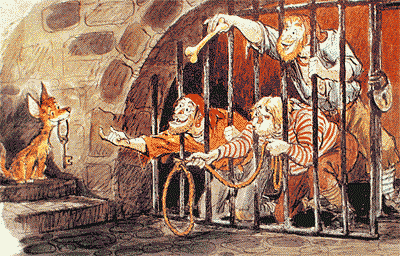 |
He recalled his process of creating characters as being
more fanciful than realistic: "The pirates finally
used in the ride were mostly my inventions, since I moved
away from the historical to create something more humorous."
In an interview with "The 'E' Ticket" in 1999,
Marc Davis described the design process from his point of
view. "We built a model... set up like a walk-through.
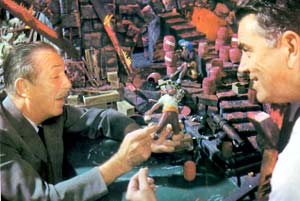 |
We made the model with openings where you could
walk in and get a view of the scenes as if you were
in the boats. That way you could get the effect of
the staging of the ride scenes, and decide if they
were going to work or not. I worked with Blaine Gibson
and his people when they were scultping the little
model figures."
|
 |
Disneyland issued
a number of photos to the press in 1965, touting the
upcoming Pirates of the Caribbean. Click
here to download a sample photo. |

Click here to continue...
|

![]()